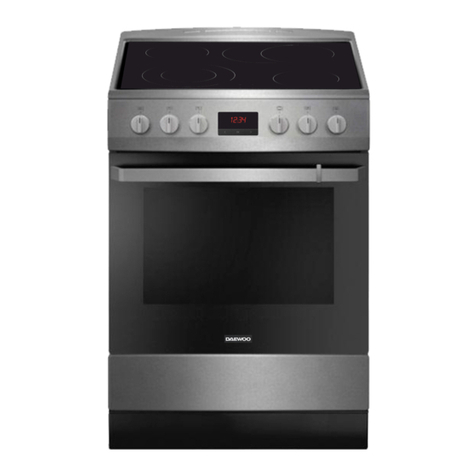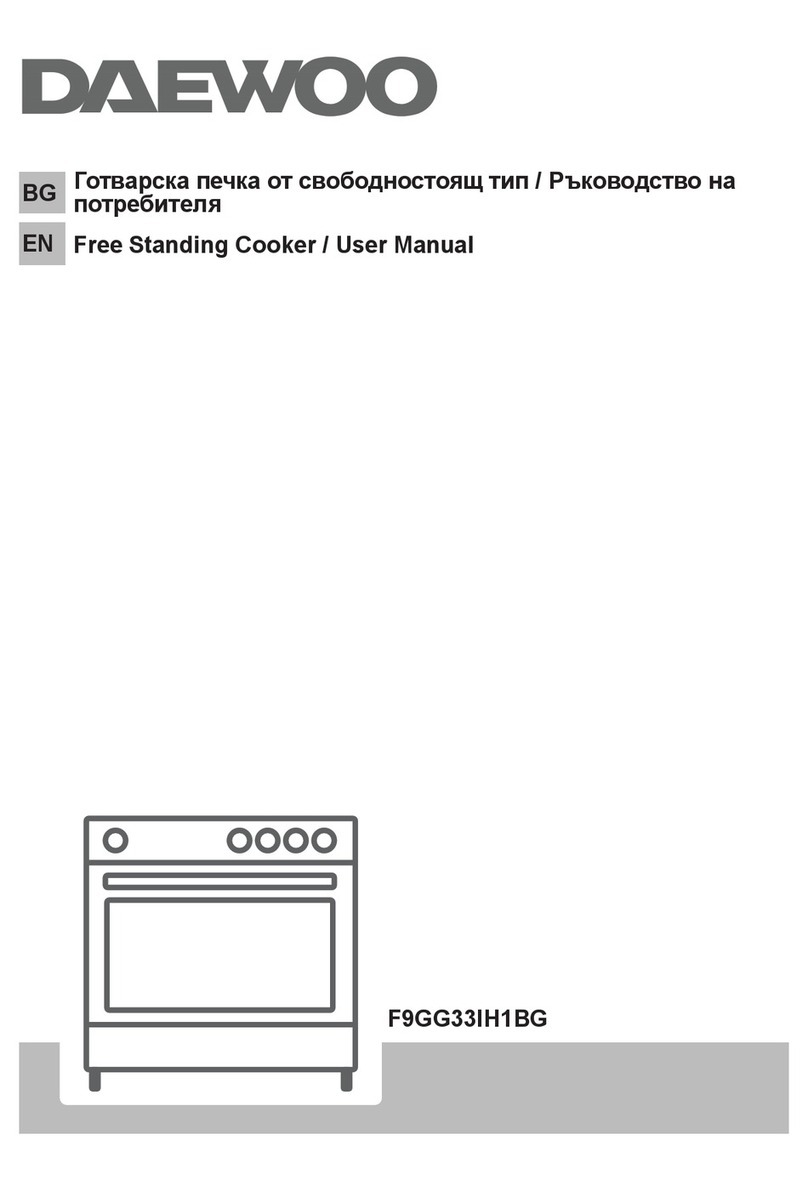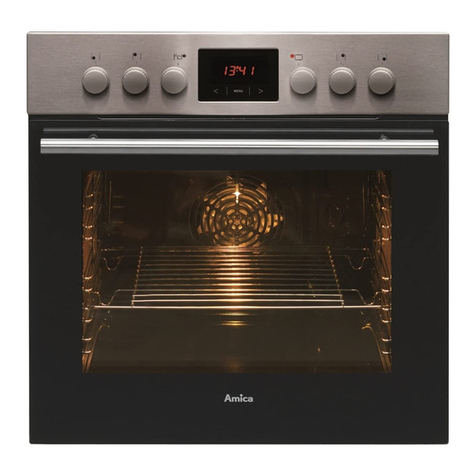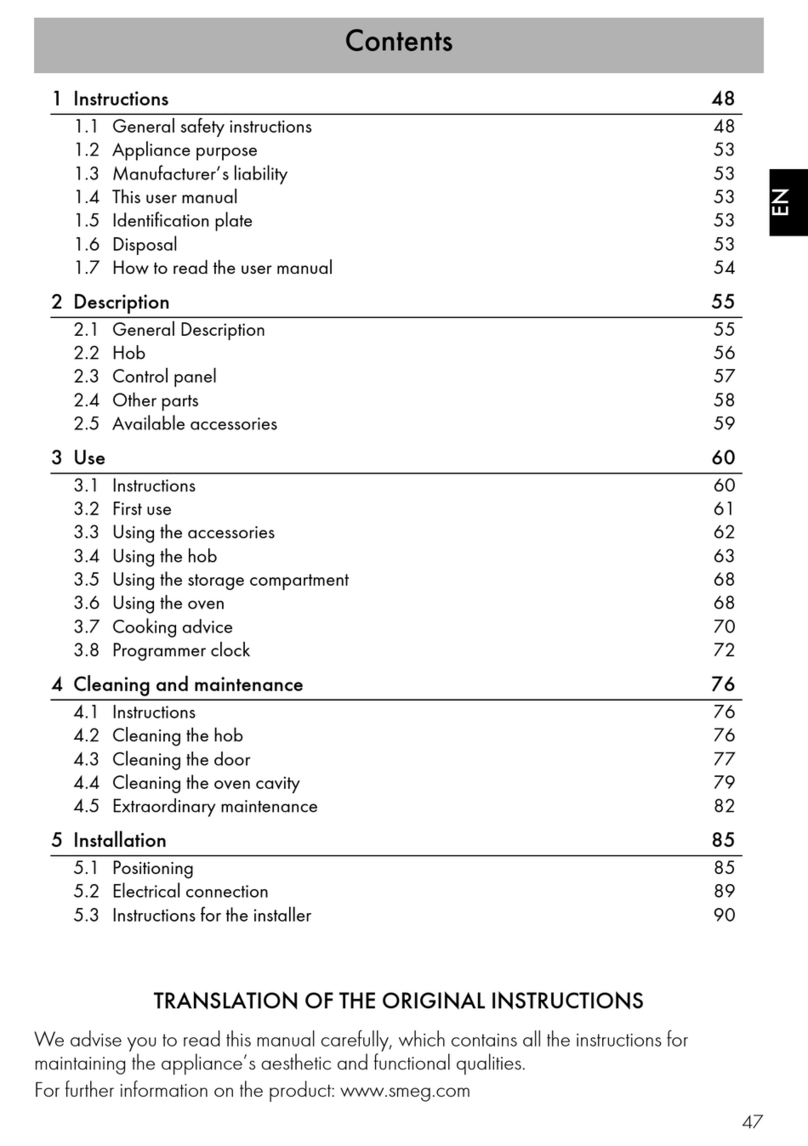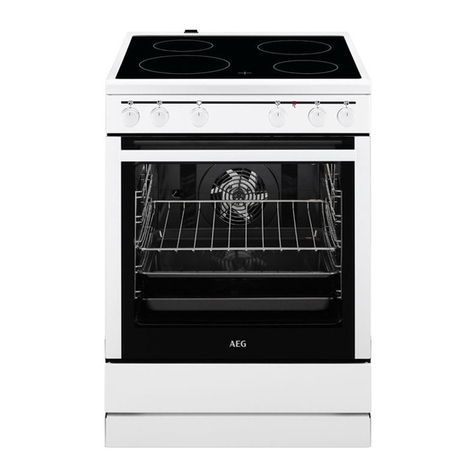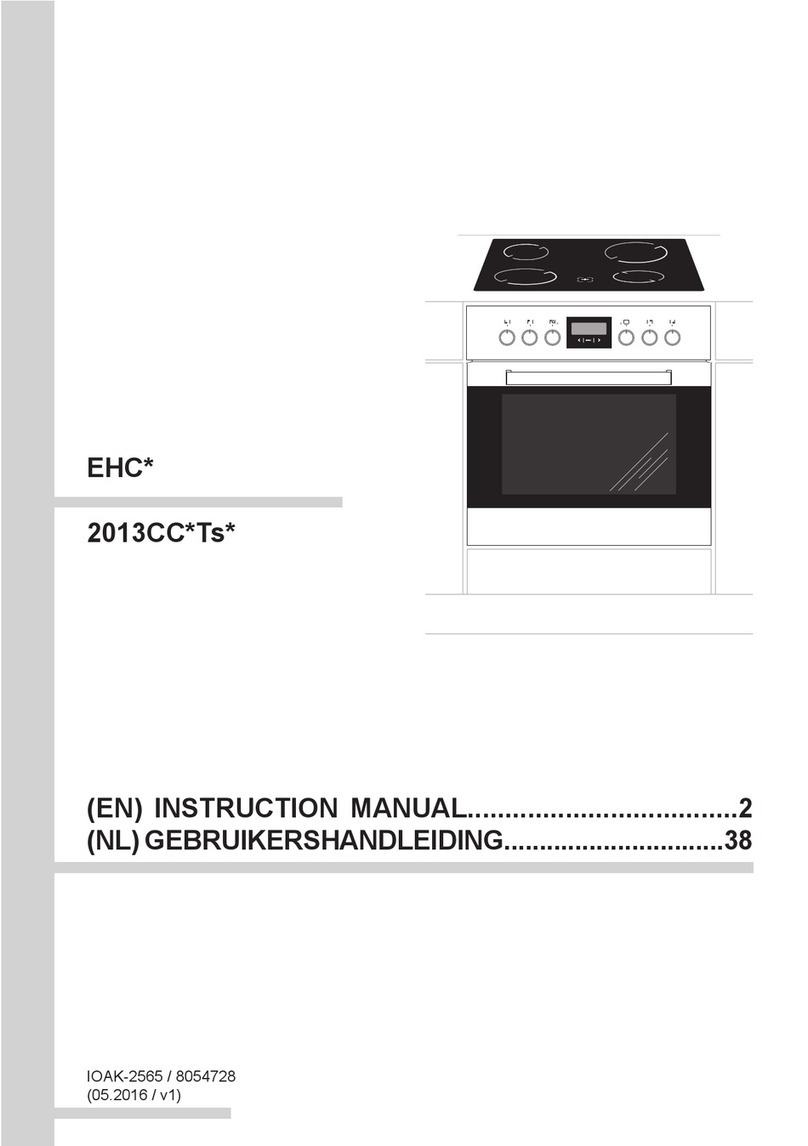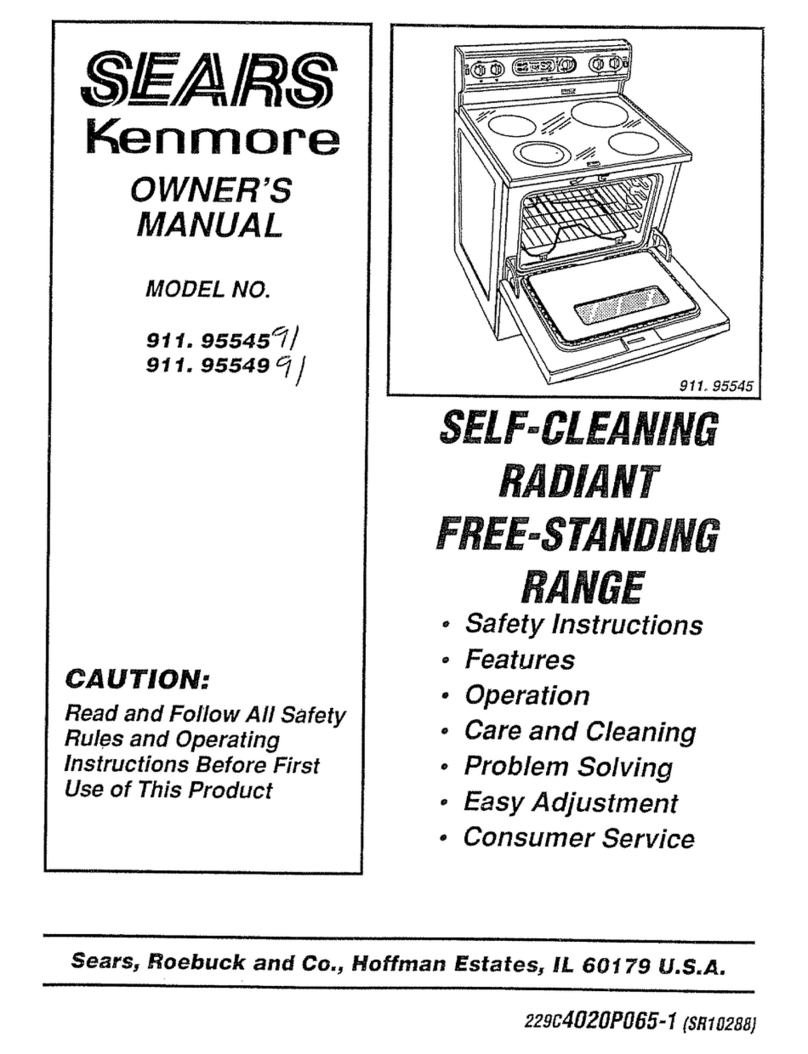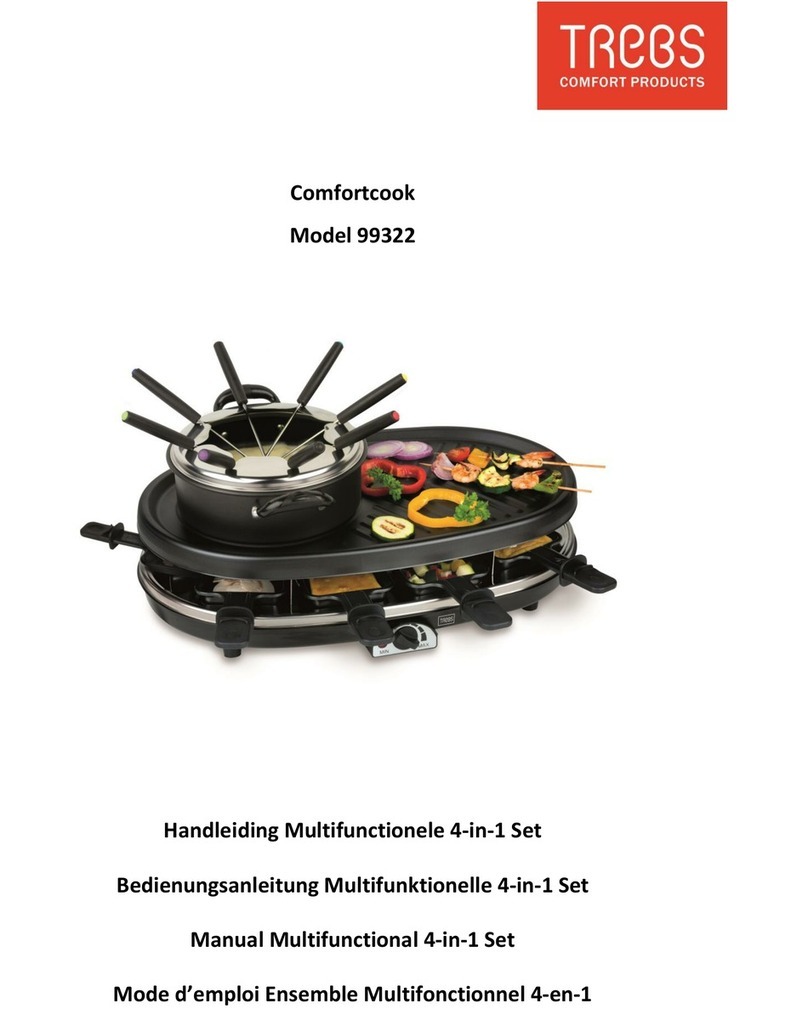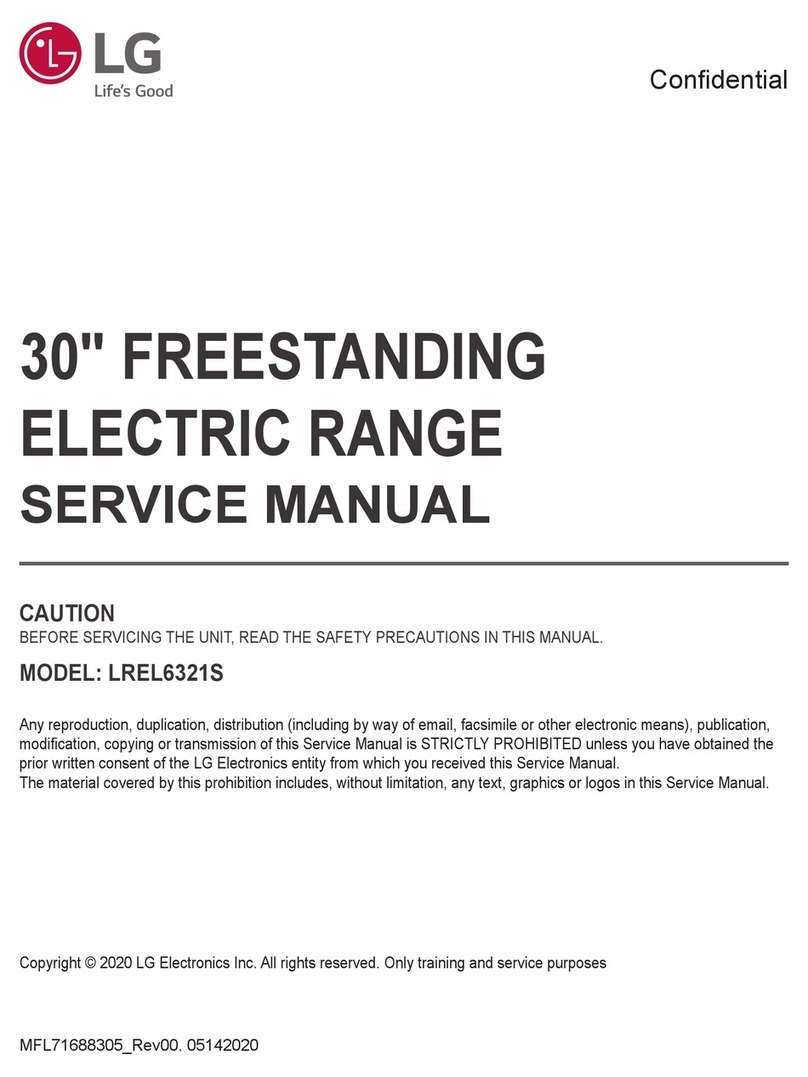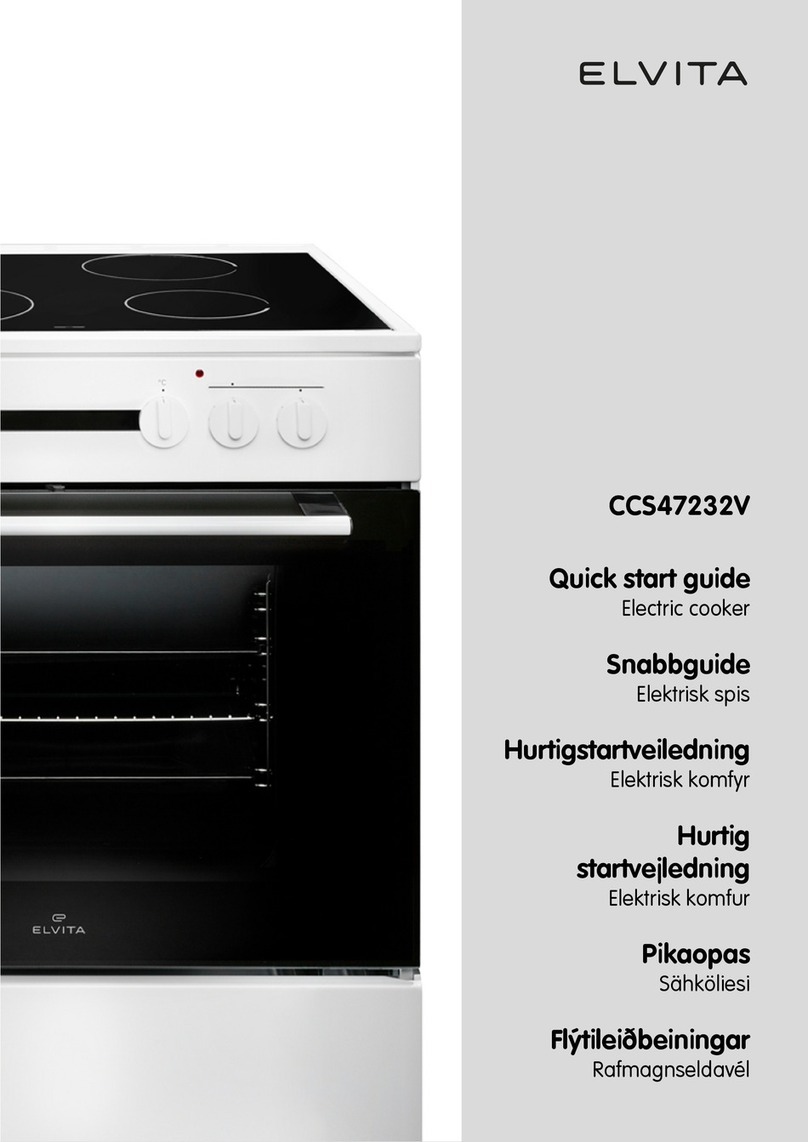Daewoo DVC-6740 User manual

DVC-6740
IOAK-2663 / 8055127
(11.2014./1)
(EN) INSTRUCTION MANUAL

2
DEAR CUSTOMER,
The cooker is exceptionally easy to use and extremely efcient. After reading the instruction
manual, operating the cooker will be easy.
Before being packaged and leaving the manufacturer, the cooker was thoroughly checked
with regard to safety and functionality.
Before using the appliance, please read the instruction manual carefully.
By following these instructions carefully you will be able to avoid any problems in using the
appliance.
It is important to keep the instruction manual and store it in a safe place so that it can be
consulted at any time.
It is necessary to follow the instructions in the manual carefully in order to avoid possible
accidents.
Caution!
Do not use the cooker until you have read this instruction manual.
The cooker is intended for household use only.
The manufacturer reserves the right to introduce changes which do not affect the
operation of the appliance.

3
Safety instructions ............................................................................................................. 4
Description of the appliance ............................................................................................. 9
Installation..........................................................................................................................11
Operation........................................................................................................................... 14
Baking in the oven – practical hints ............................................................................... 19
Cleaning and maintenance.............................................................................................. 21
Technical data................................................................................................................... 26
TABLE OF CONTENTS

4
SAFETY INSTRUCTIONS
Warning: The appliance and its accessible parts
become hot during use. Care should be taken to
avoid touching heating elements. Children less than 8
years of age shall be kept away unless continuously
supervised.
This appliance can be used by children aged from 8
years and above and persons with reduced physical,
sensory or mental capabilities or lack of experience
and knowledge if they have been given supervision or
instruction concerning use of the appliance in a safe
way and understand the hazards involved. Children
shall not play with the appliance. Cleaning and user
maintenance shall not be made by children without
supervision.
Warning: Unattended cooking on a hob with fat or
oil can be dangerous and may result in re.
NEVER try to extinguish a re with water, but switch
off the appliance and then cover ame e.g. with a lid
or a re blanket.
Warning: Danger of re: do not store items on the
cooking surfaces.

5
SAFETY INSTRUCTIONS
Warning: If the surface is cracked, switch off the ap-
pliance to avoid the possibillity of electric shock.
During use the appliance becomes hot. Care should
be taken to avoid touching heating elements inside
the oven.
Accessible parts may become hot during use. Young
children should be kept away.
Warning: Do not use harsh abrasive cleaners or
sharp metal scrapers to clean the oven door glass
since they can scratch the surface, which may result
in shattering of the glass.
Warning: Ensure that the appliance is switched off
before replacing the lamp to avoid the possibillity of
electric shock.
You should not use steam cleaning devices to clean
the appliance.

6
SAFETY INSTRUCTIONS
Always keep children away from the cooker.
While in operation direct contact with the cooker may cause burns!
Ensure that small items of household equipment, including connection leads, do not touch
the hot oven or the hob as the insulation material of this equipment is usually not resistant
to high temperatures.
Do not leave the cooker unattended when frying. Oils and fats may catch re due to
overheating or boiling over.
Do not allow the hob to get soiled and prevent liquids from boiling over onto the surface
of the hob. This refers in particular to sugar which can react with the ceramic hob and
cause irreversible damage. Any spillages should be cleaned up as they happen.
Do not place pans with a wet bottom on the warmed up heating zones as this can cause
irreversible changes to the hob (irremovable stains).
Use pans that are specied by the manufacturer as designed for use with a ceramic
hob.
If any defects, deep scratches, cracks or chips appear on the ceramic hob, stop using the
cooker immediately and contact the service centre.
Do not switch on the hob until a pan has been placed on it.
Do not use pans with sharp edges that may cause damage to the ceramic hob.
Do not look directly at the halogen heating zones (not covered by a pan) when they are
warming up.
Do not put pans weighing over 15 kg on the opened door of the oven and pans over 25
kg on the hob.
Do not use harsh cleaning agents or sharp metal objects to clean the door as they can
scratch the surface, which could then result in the glass cracking.
Do not use the cooker in the event of a technical fault. Any faults must be xed by an
appropriately qualied and authorised person.
In the event of any incident caused by a technical fault, disconnect the power and report
the fault to the service centre to be repaired.
The rules and provisions contained in this instruction manual should be strictly observed.
Do not allow anybody who is not familiar with the contents of this instruction manual to
operate the cooker.
The appliance has been designed only for cooking. Any other use (for example for heat-
ing) does not comply with its operating prole and may cause danger.

7
Using energy in a respon-
sible way not only saves
money but also helps the
environment. So let’s save
energy! And this is how you
can do it:
Use proper pans for cooking.
Pans with thick, at bases can save up to 1/3
on electric energy. Remember to cover pans
if possible otherwise you will use four times
as much energy!
Match the size of the saucepan to the
surface of the heating zone.
A saucepan should never be smaller than a
heating zone.
Ensure heating zones and pan bases
are clean.
Soils can prevent heat transfer – and repeat-
edly burnt–on spillages can often only be
removed by products which cause damage
to the environment.
Do not uncover the pan too often
(a watched pot never boils!).
Do not open the oven door unnecessarily
often.
Switch off the oven in good time and make
use of residual heat.
For long cooking times, switch off heating
zones 5 to 10 minutes before nishing cook-
ing. This saves up to 20% on energy.
Only use the oven when cooking larger
dishes.
Meat of up to 1 kg can be prepared more
economically in a pan on the cooker hob.
HOW TO SAVE ENERGY
Make use of residual heat from the
oven.
If the cooking time is greater than 40 minutes
switch off the oven 10 minutes before the
end time.
Important! When using the timer,
set appropriately shorter cooking
times according to the dish being
prepared.
Only grill with the ultrafan after closing
the oven door.
Make sure the oven door is properly
closed.
Heat can leak through spillages on the door
seals. Clean up any spillages immediately.
Do not install the cooker in the direct
vicinity of refrigerators/freezers.
Otherwise energy consumption increases
unnecessarily.

8
During transportation, protec-
tive packaging was used to
protect the appliance against
any damage. After unpack-
ing, please dispose of all
elements of packaging in a
way that will not cause dam-
age to the environment.
All materials used for packaging the appli-
ance are environmentally friendly; they are
100% recyclable and are marked with the
appropriate symbol.
Caution! During unpacking, the packag-
ing materials (polythene bags, polystyrene
pieces, etc.) should be kept out of reach of
children.
UNPACKING DISPOSAL OF THE APPLIANCE
Old appliances should not sim-
ply be disposed of with normal
household waste, but should
be delivered to a collection and
recycling centre for electric and
electronic equipment. A symbol
shown on the product, the
instruction manual or the packaging shows
that it is suitable for recycling.
Materials used inside the appliance are
recyclable and are labelled with information
concerning this. By recycling materials or
other parts from used devices you are making
a signicant contribution to the protection of
our environment.
Information on appropriate disposal centres
for used devices can be provided by your
local authority.

9
DESCRIPTION OF THE APPLIANCE
1Temperature control knob
2Oven function selection knob
3, 4, 5, 6 Heating zone control knobs
7Temperatureregulatorsignal light L
8Cooker operation signal light R
9 Oven door handle
10 Drawer
11 Ceramic hob
1
7
3, 4
2
5, 6
8
9
10
11

10
*optional
SPECIFICATIONS OF THE APPLIANCE
Ceramic hob:
Baking tray* Grill grate
(drying rack)
Roasting tray*
Cooker ttings:

11
INSTALLATION
Installing the cooker
The kitchen should be dry and airy and
have effective ventilation according to the
existing technical provisions.
The room should be equipped with a ven-
tilation system that pipes away exhaust
fumes created during combustion. This
system should consist of a ventilation
grid or hood. Hoods should be installed
according to the manufacturer’s instruc-
tions. The cooker should be placed so
as to ensure free access to all control
elements.
Coating or veneer used on tted furniture
must be applied with a heat resistant
adhesive (100°C). This prevents surface
deformation or detachment of the coat-
ing. If you are unsure of your furniture’s
heat resistance, you should leave ap-
proximately 2 cm of free space around
the cooker. The wall behind the cooker
should be resistant to high temperatures.
During operation, its back side can warm
up to around 50°C above the ambient
temperature.
The cooker should stand on a hard, even
oor (do not put it on a base).
Before you start using the cooker it should
be leveled, which is particularly important
for fat distribution in a frying pan. To this
purpose, adjustable feet are accessible
after removal of the drawer. The adjust-
ment range is +/- 5 mm.
Mounting the overturning prevention
bracket.
The bracket is mounted to prevent overtur-
ning of the cooker. When the overturning
prevention bracket is installed, a child who
climbs on the oven door will not overturn the
appliance.
Cooker width W 600 mm, height 850 mm
X1=Y+30 mm
X2=Y+65 mm
Y=30 mm
Cooker width W 600 mm, height 900 mm
X1=Y+30 mm
X2=Y+65 mm
Y=80 mm
X - distance to wall mounting
Y - distance from the oor
Y
X1
X2
Cooker
Floor
Wall

12
2
1
INSTALLATION
Electrical connection
Warning!
All electrical work should be carried out by a
suitably qualied and authorised electrician.
No alterations or wilful changes in the electric-
ity supply should be carried out.
Fitting guidelines
The cooker is manufactured to work with
three–phase alternating current (400V
3N~50Hz). The voltage rating of the cooker
heating elements is 230V. Adapting the
cooker to operate with one-phase current is
possible by apropriate bridging in the connec-
tion box according to the connection diagram
below. The connection diagram is also found
on the cover of the connection box. Remem-
ber that the connection wire should match
the connection type and the power rating of
the cooker.
The connection cable must be secured in a
strain–relief clamp.
Warning!
Remember to connect the safety circuit to the
connection box terminal marked with . The
electricity supply for the cooker must have a
safety switch which enables the power to be
cut off in case of emergency. The distance
between the working contacts of the safety
switch must be at least 3 mm.
Before connecting the cooker to the power
supply it is important to read the informa-
tion on the data plate and the connection
diagram.
1
2
3
3
4
5

13
Caution! In the event of any connection the safety
wire must be connected to the PE terminal
Recommen-
ded
type
of connection
lead
1 For 230 V earthed one–phase
connection, bridges connect 1–2–3
terminals and 4–5 terminals, safety
wire to .
2 For 400/230 V earthed two–phase
connection, bridges connect 2–3 ter-
minals and 4–5 terminals, the safety
wire to .
3 For 400/230V earthed three–phase
connection, bridges connect 4–5 ter-
minals, phases in succession 1,2 and
3, earth to 4–5, the safety wire to .
L1=R, L2=S, L3=T, N=earth terminal, PE= safety wire terminal
INSTALLATION
H05VV-F3G4
H05VV-F4G2,5
H05VV-F5G1,5
CONNECTION DIAGRAM
Caution! Voltage of heating elements 230V
1
2
3
3
4
5

14
Remove packaging, empty the drawer,
clean the interior of the oven and the
hob.
Take out and wash the oven ttings with
warm water and a little washing–up liq-
uid.
Switch on the ventillation in the room or
open a window.
Heat the oven (to a temperature of 250°C,
for approx. 30 min.), remove any stains
and wash carefully; the heating zones
of the hob should be heated for around
4 min. without a pan.
Before rst use
OPERATION

15
WRONG WRONG WRONG WRONG
RIGHT
OPERATION
Controlling the heating zones of the ceramic hob.
Choice of cookware
Choose a pan with a diameter that is at least as large as the heating zone. Do not use pans
with a concave or convex base. Always remember to put a proper cover on the pan. We
recommend the use of pans with thick, even bases.
If the heating zones and pans are solied it is impossible to make full use of the heat.
Heat level selection
The heating zones have different levels of heat. The level of heat can be adjusted gradually
by turning the appropriate knob to the right or left.
0Switch off
● MIN. Warming up
1Stewing vegetables, slow cooking
● Cooking soups, larger dishes
2Slow frying
●Grilling meat, sh
3MAX. Fast heating up, fast cooking, frying
0
1
2
3

16
Zone heating indicator
OPERATION
Zone heating indicator
If the temperature of a heating zone exceeds
50°C this is signalled by an indicator which
lights up for that zone.
When the heating indicator lights up it warns
the person using the cooker against touching
a hot heating zone.
For about 5 to 10 minutes after a heating
zone is switched off it will still have residual
heat that can be used, for example to warm
up or keep dishes warm without switching on
another heating zone.

17
OPERATION
The oven can be switched off by setting both
of these knobs to the position “”/“0”.
Caution!
When selecting any heating func-
tion (switching a heater on etc.) the
oven will only be switched on after
the temperature has ben set by the
temperature regulator knob.
0 Oven is off
Independent oven lighting
Set the knob in this position to light up
the oven interior.
Roaster on.
Roasting is used for cooking of small
portions of meat: steaks, schnitzel,
fish, toasts, Frankfurter sausages,
(thickness of roasted dish should not
exceed 2-3 cm and should be turned
over during roasting).
Oven functions and operation.
Natural convection oven
(conventional)
The oven can be heated up using the bottom
and top heaters, and the grill. Operation of
the oven is controlled by the oven function
knob – to set a required function you should
turn the knob to the selected position, and
the temperature regulator knob – to set a
required function you should turn the knob
to the selected position.
5050
100
150
200
250
C
O
00
Top and bottom heaters on
Set the knob in this position for co-
nventional baking. This setting is ideal
for baking cakes, meat, sh, bread
and pizza (it is necessary to preheat
the oven and use a baking tray) on
one oven level.
Bottom heater on
When the knob is set to this position
the oven is heated using only the
bottom heater. Baking of cakes from
the bottom until done (moist cakes
with fruit stufng).
Top heater on
When the knob is set to this position,
the oven is heated using only the
top heater, e.g. use for, nal baking
from above.

18
OPERATION
Switching on the oven is indicated by two
signal lights, R, L, turning on. The Rlight
turned on means the oven is working. If the L
light goes out, it means the oven has reached
the set temperature. If a recipe recommends
placing dishes in a warmed-up oven, this
should be not done before the Llight goes out
for the rst time. When baking, the Llight will
temporarily come on and go out (to maintain
the temperature inside the oven). The Rsig-
nal light may also turn on at the knob position
of “oven chamber lighting”.
L R Use of the grill
The grilling process operates through infrared
rays emitted onto the dish by the incandes-
cent grill heater.
In order to switch on the grill you need to:
Set the oven knob to the position marked
grill .
Heat the oven for approx. 5 minutes (with
the oven door shut).
Insert a tray with a dish onto the appropri-
ate cooking level; and if you are grilling
on the grate insert a tray for dripping on
the level immediately below (under the
grate).
Close the oven door.
Warning!
When using function grill it is rec-
ommended that the oven door is
closed.
When the grill is in use accessible
parts can become hot.
It is best to keep children away from
the oven.

19
BAKING IN THE OVEN – PRACTICAL HINTS
Baking
we recommend using the baking trays which were provided with your cooker;
it is also possible to bake in cake tins and trays bought elsewhere which should be
put on the drying rack; for baking it is better to use black trays which conduct heat
better and shorten the baking time;
shapes and trays with bright or shiny surfaces are not recommended when using the
conventional heating method (top and bottom heaters), use of such tins can result in
undercooking the base of cakes;
before the cake is taken out of the oven, check if it is ready using a wooden stick (if
the cake is ready the stick should come out dry and clean after being inserted into
the cake);
after switching off the oven it is advisable to leave the cake inside for about 5 min.;
the baking parameters given in Table are approximate and can be corrected based
on your own experience and cooking preferences;
if information given in recipe books is signicantly different from the values included
in this instruction manual, please apply the instructions from the manual.
Roasting meat
cook meat weighing over 1 kg in the oven, but smaller pieces should be cooked on
the gas burners.
use heatproof ovenware for roasting, with handles that are also resistant to high
temperatures;
when roasting on the drying rack or the grate we recommend that you place a baking
tray with a small amount of water on the lowest level of the oven;
it is advisable to turn the meat over at least once during the roasting time and during
roasting you should also baste the meat with its juices or with hot salty water – do
not pour cold water over the meat.

20
BAKING IN THE OVEN – PRACTICAL HINTS
Caution!
The gures given in Tables are approximate and can be adapted based on your own
experience and cooking preferences.
* Baking smaller items
Type
of
dish
Oven
functions
Temperature Level Time
in minutes
160 - 200 2 - 3 30 - 50
160 - 180 2 20 - 40*
220 - 240 3 10 - 15
210 - 220 2 45 - 60
250 4 14 - 18
225 - 250 2 120 - 150
160 - 230 2 90 - 120
160 - 180 2 45 - 60
190 - 210 2 40 - 50
Natural convection oven (conventional)
Table of contents
Other Daewoo Cooker manuals
